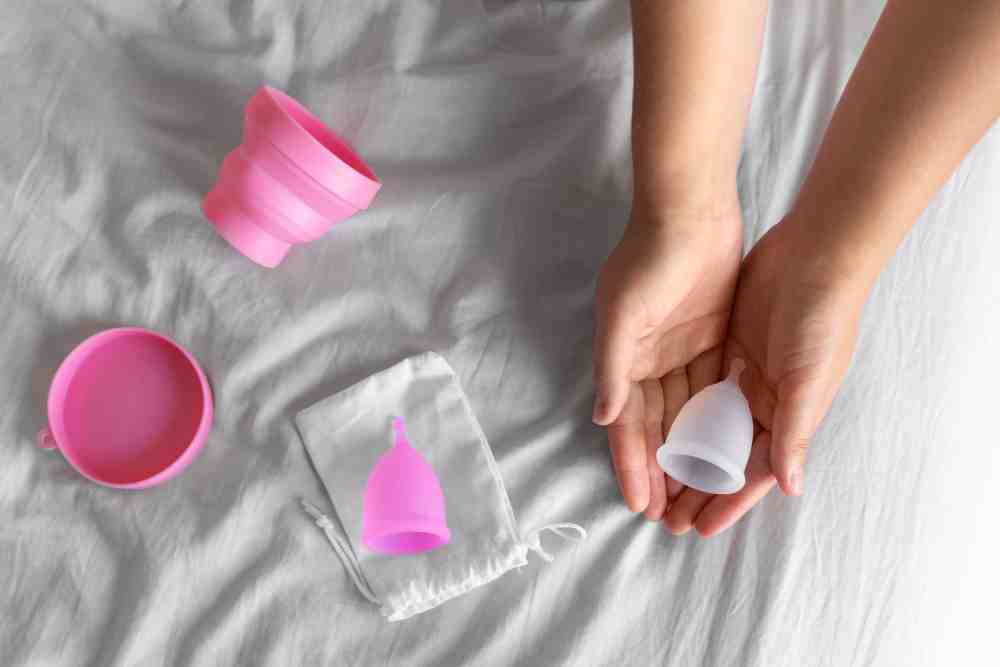
[adinserter block=”3″]
Well, several products are available to manage the flow of menstrual blood, among which tampons are most commonly used. Having a good night during a period can be challenging for you for several reasons. From experiencing menstrual migraines to light-night cramps, you can struggle with your sleep. But one thing you wish for is the smooth flow of blood while napping.
That makes you wonder, can you sleep with a tampon in? The answer is Yes; it is safe to sleep with a tampon in. But do not use it for more than eight hours, and also make sure the tampon has the right absorbency. Wearing it for a more extended period can lead to the risk of toxic shock syndrome(TSS). Though the syndrome is rare, it can be a fatal condition that may need quick medical care.Let us explore the article and learn more about tampon safety, symptoms of TSS, prevention measures, and alternatives to tampons.
What Happens When You Sleep With A Tampon In?
It is generally safe to sleep with a tampon in as long as you change it regularly. Tampons can be safely worn for up to 8 hours. When you sleep with a tampon in for a longer period(more than 8 hours), it may cause Toxic Shock Syndrome. Toxic Shock Syndrome(TSS) is a rare but potentially serious infection caused by harmful substances produced by bacteria like Staphylococcus aureus. These substances can lead to organ damage(that includes heart, liver failure, and kidney), shock, and sometimes death.
A tampon used for more than 8 hours can attract bacteria as these hygiene products can develop a moist and warm environment. There are chances that these bacteria can enter through the small scratches(generally caused by tampon fibers) in the vagina. This can cause Toxic Shock Syndrome, and the symptoms include:
Toxic Shock Syndrome Symptoms: TSS is a bacterial infection that may cause symptoms like:
- Fever
- Colds
- Sore throat
- Nausea vomiting
- Abdominal pain
- Diarrhea
- Headaches
- Low blood pressure
- Muscle pain or weakness
- Tenderness in the abdominal area
- Rashes or skin redness that might look like sunburns
- Bruising due to low blood platelets and further bleeding issues
- Confusion, drowsiness, or seizures
Generally, TSS needs medical attention. If you experience any of these symptoms, doctors may provide you with some medications for days. They might prescribe you intravenous antibiotics, given into your vein using an injection. In some cases, a course of antibiotics is recommended. It all depends on your infection severity. Moreover, you might also get IV injections to treat dehydration.
Prevention Measures To Prevent Toxic Shock Syndrome
You need to follow the instructions outlined by the FDA as a safety tip when using tampons while asleep. Here they are:
1. Read directions
If you want to buy tampons for a comfortable menstrual flow, consider certain factors. Firstly, always check the tampon packaging for the instructions, which the manufacturers generally mark. It will guide you on how to insert the tampon and how to remove it correctly. So, read the directions carefully for proper use of the tampons.
2. Wash your hands
We know that dirty hands are the root cause of many types of infections. That is why menstrual hygiene is important. As toxic shock syndrome is a severe bacterial infection, you must wash your hands properly before using it. If you unpack, handle, and insert the tampon inside the vagina with dirty hands, it can cause issues such as bacterial growth. So, it is necessary to always wash your hands while using a tampon as it will help prevent the growth of bacteria.
3. Change your tampons every 4-8 hours
If you wear the tampons for more than 8 hours in a day, there is a possibility of getting infected with TSS. Also, if you struggle with a heavy menstrual flow, changing the tampons on time can also help prevent period leaks. So, to avoid any symptoms of toxic shock syndrome, remove the tampons within 4 to 6 hours.
Also Read:Mistakes Most Women Make During Their Period
4. Use tampons only during periods
Tampons are mainly designed to control the flow of periods. So, please do not wear it at other times. Avoid using the tampons when not on a heavy period. If you are on the last day of your period or your menstrual flow is light, consider using panty liners or pads. Just apply a lubricating jelly when you are inserting the tampons during the last day or when there is a weak flow.
5. Use tampons with the lowest absorbency
Regarding the frequency of period flow, the absorbency of tampons matters. Bigger-size tampons are effective for heavy menstrual flow, while the smaller ones are for light flow. Hence, it is essential to consider absorbency. There are more chances of developing TSS if you wear high-absorbency tampons. it is better to use the one with the lowest absorbency.
6. Use tampons once
The FDA has approved the use of tampons only once. So, do not use it twice or more, and never buy the tampons that are claimed to be reusable. Too much use of tampons can potentially cause Toxic shock syndrome. Though this bacterial infection is rare, it can be life-threatening, which is caused by some bacteria. These toxins enter the bloodstream and can severely impact the body is parts like kidneys, heart, and liver.
7. Be mindful of TSS symptoms
It is essential to be aware of the symptoms of TSS. We have mentioned all the symptoms related to Toxic Shock Syndrome above that you should mindfully go through and have a clear idea about their impacts on your body. If you notice or experience any such symptoms during or after the use of tampons, do not delay. Just seek medical care as soon as possible before the symptoms get worse.
Is It Safe To Sleep With A Tampon In?
Wearing a tampon while you are on your periods may be safe, but under some conditions. If you use it for longer than 8 hours, you can struggle with the risk of (TSS) toxic shock syndrome. TSS can spread rapidly, impacting all body parts, and can be fatal if not treated soon.
So, the safety of tampon use while sleeping altogether depends on how properly you take the safety approaches, as summarized by the FDA. Typically, it would help if you changed the tampon every 4-8 hours. Please do not wear it for more than 8 hours. Also, make sure the tampon has the lowest possible absorbency.The absorbency of the tampon tells how much blood it can soak. So, always check the absorbency information on the packaging. The higher the absorbency, the more the risk of Toxic Shock Syndrome.
Can You Sleep In A Tampon?
If you are menstruating, can you sleep with a tampon in? Then, absolutely yes, but with some safety tips:
1. Wear the tampon just before the bedtime
If you want to put the tampon in at night time, make sure to use it before bedtime. If you wear it a few hours before going to bed, this will unknowingly add hours to the tampon use and reduce the set time limit.
2. Determine the right absorbency for your menstrual flow
There is always a question of leakage. Many women find it required to change the tampon every 4 to 6 hours, particularly during the heavy flow days. But if you want to wear it at night, you would definitely be sleeping with it for longer than 4 to 6 hours. So, it will be better to determine the absorbency of your menstrual flow and then figure out which size of tampon will be the right pick for overnight wear.
3. Set an alarm
Not sure if you will wake up after 8 hours while you sleep with a tampon in? Then, better to set an alarm. This will help you get up on time to change the tampon before the fixed time. If the alarm does not wake you or you may choose to wear a pad instead of a tampon.
4. Use pantyliner for extra protection
If you have heavy menstrual flow, you can pair a tampon and pantyliner for extra protection the whole night. Panty liners are much more flexible than pads, making them comfortable to use during the night. So, always wear high-quality pantyliners that are 100% organic, breathable, and safe for sensitive skin.
It depends on your sleep schedule. If you prefer to sleep for 6-8 hours, then it is OK to wear it to bed. But you need to keep an essential point in consideration: insert it before going to bed and change it immediately after you wake up.
If your sleep schedule is more than 8 hours, then you need to try some other hygiene products instead of tampons. Some women prefer pads or menstrual cups, while others choose lined menstrual underwear for free bleeding.
If you want to use menstrual cups, make sure to clean them entirely in between the uses. According to a study, a woman aged 37 years has been suspected of toxic shock syndrome(TSS) when using a menstrual cup. So, it is always advised by healthcare providers to wash their hands while inserting, emptying, and removing the menstrual cups.
Many women prefer to avoid using tampons at night. Choosing the tampon alternatives can be helpful in such cases that include:
1. Disposable Menstrual Pads
Also known as sanitary napkins, these menstrual hygiene products are most commonly used. Unlike tampons, they remain outside the vagina and are attached to the underwear. There is less risk of developing toxic shock syndrome on using disposable pads than tampons.
2. Reusable Menstrual Pads
Like disposable pads, these pads also remain out of the body and stick in the underwear. Made of washable fabrics, you can clean, dry, and wear them again. They can be washed in dryers and washing machines.Research says that most women prefer to use these pads for effectiveness, safety, and affordability, and also they are more environmentally friendly.
3. Menstrual Underwear
These period underwear work similarly to pads that are designed as underwear. Instead of attaching a pad to underwear, you can wear the underwear and manage your blood flow. You can find these underwear in both disposable and reusable form. Most women who worry about menstrual blood leakage after using pads find more interest in menstrual underwear. According to a study, menstrual underwear gives comfort, good absorbent capacity, and hygiene and is easy and quick to use. Since the underwear is absorbent, leaking problems become less.
4. Menstrual Cups
Also known as vaginal cups or period cups, they are inserted inside the vagina like tampons. But, they do not absorb the menstrual blood; instead, the cup accumulates the blood, which is later emptied. Usually, tampons last for up to 8 hours, and menstrual cups can be reused for 12 hours, saving you money. These cups may be rarely linked with TSS.Research says menstrual cups are safe alternatives, but more study is needed for their environmental effect and cost-effectiveness compared to other menstrual products.
Also Read:Vaginal Discharge: What is not normal?
Can you pee with a tampon in?
Many women wonder if it is safe to pee with a tampon in. Typically, it is safe to urinate while a tampon is inserted. Urine comes through the bladder, while period blood comes out of the uterus and travels through the cervix before leaving the body. However, if you have an Urinary Tract Infection(UTI), you should not practice wearing tampons. It will be better to use sanitary pads. If the symptoms of UTI continue, seek professional help and get tested.
Conclusion
Well, it is safe to use the tampon while sleeping, but only if you are keeping it for more than 8 hours. Additionally, it is important to change it every 4-6 hours to prevent the risk of toxic shock syndrome. It is safest to use the tampons with the lowest absorbency. Keep in mind, if you find any TSS syndrome, seek medical help as soon as possible.
[adinserter block=”3″]
Credit : Source Post






